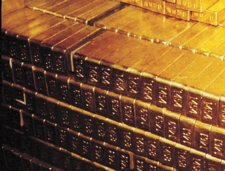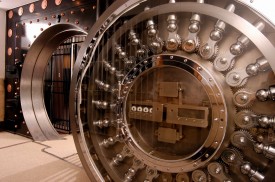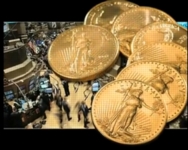 November 15, 2017 ~ The United States embraced the principle of a gold standard – a dollar whose value was linked to a defined quantity of gold – from 1789 to 1971, a stretch of 182 years. During this time, the U.S. was the most successful of any major country, expanding from thirteen war-ravaged states along the Atlantic seaboard to a world economic superpower, with the broadest and wealthiest middle class the world had ever seen. The U.S. dollar was the premier international currency, and New York was the world’s financial capital.
November 15, 2017 ~ The United States embraced the principle of a gold standard – a dollar whose value was linked to a defined quantity of gold – from 1789 to 1971, a stretch of 182 years. During this time, the U.S. was the most successful of any major country, expanding from thirteen war-ravaged states along the Atlantic seaboard to a world economic superpower, with the broadest and wealthiest middle class the world had ever seen. The U.S. dollar was the premier international currency, and New York was the world’s financial capital.
If the U.S.’s gold standard policy was a mistake, as nearly all academic economists claim today, shouldn’t there have been some evidence of that, after nearly two centuries? Shouldn’t there have been some kind of negative consequences? Shouldn’t there have been some other government, somewhere, that did even better, with a different approach?
 The last twenty years of this period – the Bretton Woods era of the 1950s and 1960s, when the dollar was worth 1/35th of an ounce of gold – was the most prosperous time of the last century, not only in the U.S., but around the world. Nobody wanted the good times to end. There was never an international conference where governments agreed to adopt a new world monetary system. When President Richard Nixon “closed the gold window” on August 15, 1971, he said it would be a temporary measure. And indeed it was: Nixon himself organized the Smithsonian Agreement a few months later, in which world governments earnestly cooperated to restore the Bretton Woods framework of fixed exchange rates, and refix the dollar to gold at $38/oz. But, they didn’t know how.
The last twenty years of this period – the Bretton Woods era of the 1950s and 1960s, when the dollar was worth 1/35th of an ounce of gold – was the most prosperous time of the last century, not only in the U.S., but around the world. Nobody wanted the good times to end. There was never an international conference where governments agreed to adopt a new world monetary system. When President Richard Nixon “closed the gold window” on August 15, 1971, he said it would be a temporary measure. And indeed it was: Nixon himself organized the Smithsonian Agreement a few months later, in which world governments earnestly cooperated to restore the Bretton Woods framework of fixed exchange rates, and refix the dollar to gold at $38/oz. But, they didn’t know how.
The immediate result was an economic disaster – the “stagflation” of the 1970s. Considerable recovery was achieved during the “Great Moderation” of the 1980s and 1990s, when the dollar’s value was held around $350/oz. of gold – by intent or by accident, a crude gold standard system. (Alan Greenspan, who presided over much of this time at the Federal Reserve, has hinted rather heavily that this was on purpose.) After 2000, the dollar’s value declined again vs. gold, from around $300/oz. to a nadir near $1900/oz., and then bounced around rather turbulently. Another era of stagnation and disappointment, accompanied by a serial rotation of strange “asset bubbles,” was the result.
Paul Krugman, on the Left, once called this post-1971 experience the “Age of Diminished Expectations.” Tyler Cowen, on the Right, called it the “Great Stagnation.” If floating-currency chaos and macroeconomic manipulation by central banks was such a brilliant innovation, shouldn’t there be some evidence of that, after forty-six years?
 Even today, the American people can still tell the difference between success and failure. A 2011 poll found that 57% of voters would favor a gold standard system if “it would reduce the power of bankers and political leaders to steer the economy.” Only 19% opposed.
Even today, the American people can still tell the difference between success and failure. A 2011 poll found that 57% of voters would favor a gold standard system if “it would reduce the power of bankers and political leaders to steer the economy.” Only 19% opposed.
Forget all the silly claims that humanity’s long affinity for gold-based money is due to some kind of “superstition,” “mania,” obsession,” or “fetish.” Economic thinkers have long known that the best money is money that is stable in value, in much the same way as other weights and measures, such as grams, meters or minutes, also remain fixed and unchanging. “The one essential quality that is needed in the article which we use as a basis for exchanging all others is fixity of value,” Andrew Carnegie explained in 1891, repeating what had been conventional wisdom for centuries.
The market economy’s basic processes require a stable monetary unit. When the price of oil goes up, more investment and production may follow, while users may reduce their consumption. This is a beneficial and productive response if it is due to real changes in the supply and demand of oil; and a nonsensical or destructive response if it is caused by changes in the money. As described in insight-laden detail by George Gilder in The Scandal of Money (2016), money acts as a sort of information system for the economy. The economy is guided by the economic “signals” of prices, profit margins, interest rates and returns on capital. The “noise” of the carrier – the money – must be as little as possible.
The gold link produced this necessary stability. Its imperfections were minor enough that they didn’t matter very much. Nobody has found a better way. Mostly, they didn’t feel the need to look for one.
The International Monetary Fund categorizes roughly two-thirds of all countries today as having some sort of fixed-value arrangement, mostly linked to the dollar or euro. In doing so, governments mostly, or completely, give up domestic macroeconomic management via currency distortion. The main difference between a “dollar bloc” and a “gold bloc” is the choice of the standard of value.
 The best way to achieve this fixed-value link is with some sort of automatic system similar to today’s currency boards. In practice, currency boards are highly reliable, and are not prone to the kinds of disasters that “pegged” systems suffer constantly – including the disintegration of Bretton Woods’ $35/oz. gold “peg.” This is critical knowledge that will enable us to avoid that traumatic outcome, and instead create the kind of quiet reliability that the British pound enjoyed for more than two centuries before 1914.
The best way to achieve this fixed-value link is with some sort of automatic system similar to today’s currency boards. In practice, currency boards are highly reliable, and are not prone to the kinds of disasters that “pegged” systems suffer constantly – including the disintegration of Bretton Woods’ $35/oz. gold “peg.” This is critical knowledge that will enable us to avoid that traumatic outcome, and instead create the kind of quiet reliability that the British pound enjoyed for more than two centuries before 1914.
Governments should still be ambitious about managing the domestic macroeconomy–but not through monetary distortion. Tax reform, regulatory reform, educational reform, welfare reform, abundant capital creation, and a dozen other advances promise the kind of fundamental and lasting improvements that monetary manipulation can never provide. You can’t money-twiddle your way to prosperity. No country ever has. Haven’t we learned this by now?
Written by Nathan Lewis and published by Forbes ~ November 15, 2017.

“Gold, Mr. Bond.”
FAIR USE NOTICE: This site contains copyrighted material the use of which has not always been specifically authorized by the copyright owner. We are making such material available in our efforts to advance understanding of environmental, political, human rights, economic, democracy, scientific, and social justice issues, etc. We believe this constitutes a ‘fair use’ of any such copyrighted material as provided for in section 107 of the US Copyright Law. In accordance with Title 17 U. S. C. Section 107, the material on this site is distributed without profit to those who have expressed a prior interest in receiving the included information for research and educational purposes. For more information go to: http://www.law.cornell.edu/uscode/17/107.shtml








